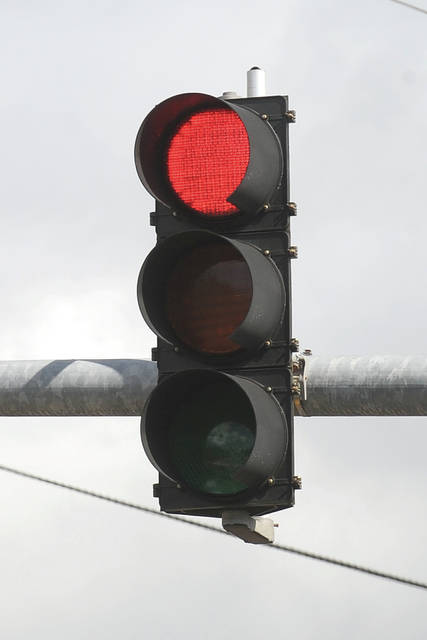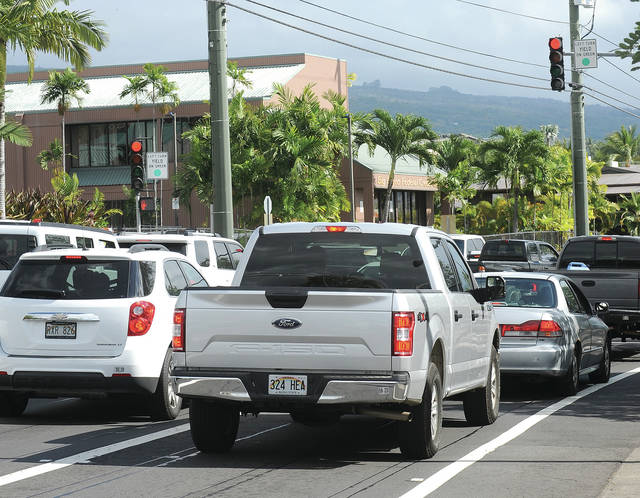KAILUA-KONA — A bill proposing a red light detector systems program overcame its first hurdle Thursday, clearing a joint judiciary and transportation committee, and is now waiting to be heard by the Committee on Ways and Means.
There has been overwhelming support for Senate Bill 663 – from state departments to county officials, to bicycle organizations down to the private citizen.
Sen. Lorraine R. Inouye (D-North Hawaii) is a co-sponsor of the measure. The purpose of the bill is to establish a photo red light detector systems program to deter motorists from running red lights and free police officers to respond to priority calls.
Hawaii County’s Office of the Prosecuting Attorney was one of the many that submitted testimony in favor of the measure.
“Record numbers of pedestrians, as welt as people biking and driving are injured or killed on our streets by irresponsible drivers. Everyone has the right to be safe on Hawaii’s roads,” prosecutor’s office testimony states.
Only two testimonies submitted opposed the bill — the Office of the Public Defender and an individual.
“Although we believe that strict enforcement of our traffic laws results in a reduction of traffic accidents and increased traffic safety, we do not believe this measure appropriately balances the rights of the accused violators with the public’s interest in traffic safety,” testimony from the Public Defender’s office states.
The Committee on Transportation passed the measure with amendments by a 3-2 vote. The Committee on Judiciary passed it with amendments 4-1 with one reservation.
Amendments to the bill include $200,000 funding for 2019-20 and 2020-21 from the State Highways Division, insertion of fines, language that includes who sees and uses the photos taken and language that includes after a certain period of time the photos will be deleted.
According to Hawaii Police, from Jan. 1 to June 30, 2018, there were 110 red light violations islandwide; 44 of those occurred in the department’s Kona District, which comprises the physical areas of North and South Kona. Maj. Robert Wagner said a red light violation is defined as when a motorist enters an intersection when the light is red.
“If you enter with yellow and leave when red, that is not a red light violation,” he said.
Senate Bill 663 outlines numerous benefits to enacting the program. Not only are streets safer, but police officers are freed from “time-consuming duties” of traffic enforcement and have time to respond to priority calls. Also violators are less likely to go to court because of the photograph, which can be used as evidence against them.
A date for the bill to be heard by the Senate Committee on Ways and Means has not yet been set.





The costs will be certain. The alleged safety benefits seem less certain to me. Is there a study available from any town in the US that shows the desired results were achieved?
Re: police offers now having time to respond to priority calls — is there any supervising police official who has ever prevented such priority response to date? (“Ignore that active shooter, do not leave that intersection until you find and ticket a red light violation!”) Or more likely is this justification complete hogwash, yet repeated unquestionably as if it makes sense? And even if there were some marginal benefit, how much more police time could be acquired via spending this money directly on police officers?
Of accidents or injuries caused by intentional running of red lights in Kona — (how many are there really?) — how many of those would have been stopped by a camera on what I’m guessing will be no more than several lights? Certainly not the ones where it was a drunk or otherwise diminished capacity driver, a pure accident, or otherwise unintentional. I asked this question in a prior thread and someone mentioned a tragic situation in Honolulu involving a drunk driver and a police chase. I’d respectfully submit that someone who is refusing to pull over despite an active police pursuit is unlikely to surrender to the camera either.
The other implication that is certain is that we will be authorizing our local government to install cameras, computer and network equipment that has the raw capability to track the movement of every car and store it forever, where it will be available to any government official or hacker who wants to query it for any purpose they can think of
Sure, we will hear all sorts of promises about limited use and trustworthy controls on day 1. Experience suggests unauthorized stalking of someone’s spouse or crush or child will happen by day 2. Regardless, any promised restrictions can and most likely will be relaxed in the future. Don’t be surprised when a few years from now they float a new tax to be billed to you for each car trip through town, straight to a credit card the DMV required you to provide when you registered your car.
THINK AGAIN COUNTY COUNCIL!
“In a study co-authored with economist Paul J. Fisher, they examined all police-recorded traffic accidents for three large Texas cities over a 12-year period – hundreds of thousands of accidents. We found no evidence that red light cameras improve public safety. They don’t reduce the total number of vehicle accidents, the total number of individuals injured in accidents or the total number of incapacitating injuries that involve ambulance transport to a hospital”.
“Red-light cameras don’t reduce the number of traffic accidents or injuries at intersections where the devices are installed, according a new analysis by Case Western Reserve University.Touted by supporters as a way increase public safety by ticketing drivers who continue through red lights, the cameras actually shift traffic patterns: More drivers tend to brake harder and more abruptly, increasing fender-benders and other so-called “non-angle” collisions”.
“Once drivers knew about the cameras, they appeared to accept a higher accident risk from slamming on their brakes at yellow lights to avoid an expensive traffic citation—thereby decreasing safety for themselves and other drivers,” said Justin Gallagher, an assistant professor of economics at Weatherhead School of Management at Case Western Reserve.
Create a hotline where the public can easily report timing problems with Kona’s traffic lights and have a team available to respond to those reports in a timely manner .
Just a way for them to spy on us. Data shows it does not work anyway.
Adding one second to the yellow intervals on the lights would almost certainly drop the violation rates by at least 60% and more likely by about 80%. Don’t look for this safety improvement to happen if the cameras are approved, because it guts the loot from the for-profit red light camera rackets that no state should ever use.
James C. Walker, National Motorists Association